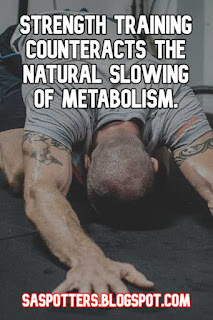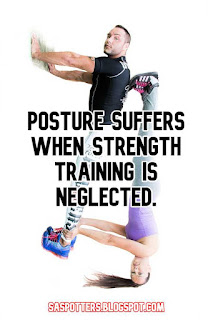 |
| Strength training is very beneficial. |
By Rob Maxwell, M.A. Exercise Physiology, CSCS, ACSM CPT from www.fittothemax.net. Follow him on Twitter.
The Benefits of Strength Training
Strength training is no longer just for the so called 'jocks' and 'muscle heads' anymore. Most of us already know that, right? This is nothing new, but I think that many of us still struggle with that generalization.
When I started strength training in the late 80’s, I was in my teens and (like many other teens in the throes of puberty) I wanted to be stronger and look better.
Back then, I would say that people were still going to the gym mostly for that reason. This was in the 1980’s.
Now research and experience has shown us that strength training has far more benefits than just getting strong and buff. Let's take a look at them.
 |
| Train for the sake of a better life. |
1. Strength training for general or functional strength
There is a difference between maximal strength and general strength.
Maximal strength is being able to lift or move something one time. When a person speaks of their bench press and states that they can bench press a certain weight, this is maximal strength. That is a big goal in power lifting and sport conditioning.
General strength is simply being strong. Strength is important. You want to open that pickle jar, lift a box and get out of a chair. These are all components of strength.
We use a term called ADL’s in training. This stands for Activities of Daily Living. This means being able to do real life activities that you have always done.
More people are coming to my personal training gym so that they can improve in this area.
Your kids want you to go to a theme park, but you don't feel like you have the strength and stamina to do so. This is one example. You go to a grocery store, but you cannot lift the big bag of dog food into the cart. You don’t have the strength to carry your grand kids. That's another example.
We all want to be independent. We want to be able to do these things for ourselves. Strength training is important for keeping our body strong so that we can continue to be able to do all the things that we want to do.
 |
| Train today and be strong tomorrow. |
2. Strength training to tone or build muscle
Strength training adds muscle - and that is a good thing.
Hypertrophy refers to muscle cell enlargement. That is what toning is. Tone is simply a partially contracted muscle. When you have less body fat, with muscle, you will look more defined.
It is important to have muscle on your body. You don't need to worry unless you have the genetics of a body builder. You will not 'bulk up' by accident. It does not work that way.
As you and I age, we lose muscle tissue - unless we are working out and putting muscle on. We want to keep as much muscle as possible because muscle mass boosts our metabolism.
 |
| Everybody needs to look after their muscles. |
3. Strength training to boost your metabolism
As I have stated above, muscle mass improves your metabolic rate. The only way that we can increase our metabolic rate is by adding muscle.
The resting metabolic rate accounts for 60-75% of all the energy that we can burn. Energy means calories.
Have you heard of creeping obesity? This means that over the years people start to put on a few pounds every year until they become obese.
Many blame the metabolism for slowing down naturally. That may be a cause, but it slows down because people become inactive and they start losing muscle mass.
Combine natural regression with less energy being burned (lack of exercise) and the same or greater food intake... and you have weight gain.
What is the answer? Do not slow down! Stay active.
The most important thing is to always keep strength training in the routine. This will keep the muscle mass up and the metabolism up.
 |
| Move it or lose it. |
4. Strength training to prevent future injuries
One of the most frustrating things I hear people say is they are not going to the gym or not doing strength training because they are afraid that they are going to get hurt.
That is all wrong. One of the main ways that we can avoid injury is to strength train. This keeps the muscles that surround and support the joints strong.
Sure, you can get hurt in a gym if you are training carelessly or following one of these new trendy programs that I will not mention here.
Strength training, when done properly, is what keeps your body strong. It keeps injuries away.
Why? There are two reasons. Firstly, it strengthens the muscles that surround every joint and makes sure that the joints do not absorb all the pressure.
Secondly, it fixes muscle imbalances.
All muscles have what is called an antagonist. The antagonist is the muscle that opposes the muscle that is doing the work.
If a person has a job or plays a sport that uses one area of the body way more than its opposite muscle group, they will develop a muscle imbalance which could result in overuse injuries.
For example, a tennis player may develop nice strong fronts of the shoulders because of their stroke. If they do not balance those shoulders out, they will end up with a shoulder injury.
By going to the gym, they can train the posterior part of their deltoid and help to ensure that a tennis injury does not happen.
Strength training works by strengthening the muscles around a joint and corrects muscle imbalances.
 |
| Strength reduces injury risk. |
5. Strength training to prevent or manage osteoporosis
Osteopenia and osteoporosis is the loss of bone density. Osteopenia is the start of bone density loss. Older women with slighter builds are typically the most susceptible to this.
Weight-bearing exercises such as walking help build bone density and help to prevent its loss for sure.
While this is true, strength training has been found to be the most helpful in preventing bone density loss.
The reason is because bones, like any tissue, build up from stress. When we walk, we are putting stress on our lower body and particularly the lower legs. But the rest of the body is not being impacted.
Areas of the spine are vulnerable to bone density loss. Therefore, strength training is an enormously powerful tool. You can stress each muscle group - which will stress the joint - which will stress the bone involved in movement. This prevents bones from breaking down any further.
Bone density, at this writing, does not come back.
We can, however, prevent further break down through proper strength training - and secondarily, with weight-bearing exercise.
 |
| Exercise has a long term effect. |
6. Strength training improves posture
Quit sagging! Stop leaning over! Stand up straight! Put your shoulders back! Flaunt what God gave you!
Have you ever heard of any of these things? I am sure that you've heard at least one!
Posture is important. It says a lot of how we feel about ourselves. If we are hunched over, we may be hiding or feeling depressed or defeated.
Or it can simply mean that we have muscle imbalances from standing or sitting a certain way repeatedly. All this can be corrected by proper strength training.
When we have muscles that are overactive, they are going to pull us in a different direction. When we strength train properly, we can work the opposite motion and pull them back.
Strength training is the most important factor in posture and muscle imbalances. You can't correct a muscle that is too weak to pull its own weight.
 |
| Weak muscles hurt posture. |
7. Strength training builds your self esteem
Yes, I suppose all exercise builds your self-esteem. It’s true. But there is something special about getting stronger.
I can remember when I was a kid and had my first cement free weight set. Remember those? I had it set to bench press of course. Why do anything else? Bench press and curls baby! That is what 13-year-old boys care about. But I digress.
I remember targeting a goal of 100 pounds on the bench press. I was working hard. It wasn't smart, but I was trying to add weight every time. I wanted that 100 pounds! And I finally hit it. After a few attempts, I was able to get the barbell off my chest and all the way up.
I felt great! I felt proud! I walked a little prouder and taller. I see this all the time in other people. When they get stronger, they feel good about themselves.
Think of all the ancient gods from Greek Mythology. How were they portrayed? They are strong and muscular.
There is something that makes us feel exceptionally good and strong when we are strong!
 |
| Accomplishment matters. |
8. Strength training helps you to be better at sports
In athletics, we call them strength and conditioning programs for a reason.
I have a Certified Strength and Conditioning Specialist certification from the National Strength and Conditioning Association. I am proud of this certification. You must have at least a 4-year degree to sit for it. It is challenging and particularly good.
Sports have become big business, so teams want trainers that know what they are doing.
Strength and conditioning can be taken too far with athletes these days, especially younger athletes. Our athletes are overtrained.
But correctly done strength and conditioning programs will, without a doubt, make you better at your sport.
I do not agree with all the specificity that goes into some of these programs. I do not think that working on a golf swing like exercise at the gym will make you swing a golf club better. I think swinging a golf club will make you swing it better.
But I do believe that working on all the general strength and conditioning exercises will make an athlete significantly better at his or her sport.
If you are in great shape you will not get tired no matter what you are doing. If you are not getting as tired as usual, you can stay on top of your game for longer without injury.
It is extremely hard to focus and move safely when fatigued. In fact, you may have heard the saying that 'fatigue makes cowards of us all'. It is true. And I already covered injury prevention above, but suffice it is to say strength training is a great insurance policy against getting muscle and joint injuries.
This is critically important for athletes, correct? Again, you must do the program the right way. You do not want to over train and work all the muscle groups you are already using in your sport.
 |
| Focus on strength, endurance and injury prevention. |
9. Strength training for weight loss or fat loss
I had to put weight loss all the way down here to get you to read to this part!
We talk about weight loss, but its fat loss that really counts. Do we really want to lose weight indiscriminately or do we want to lose fat?
Correct: we want to lose fat. If you stated that it does not matter, quit reading and call me right away.
We want to lose fat. Studies show that diet alone can lead to some weight loss. Diet with cardio can lead to even more weight loss than just dieting alone. But diet with cardio and strength training leads to fat loss and muscle gain or at least muscle retention.
We don’t want to lose muscle when we lose weight because when we lose muscle, we slow our metabolism down.
We want to lose fat. We lose fat via strength training by increasing muscle mass and thus raising the resting metabolic rate. Strength training burns calories.
Strength training also promotes after burn, which means that you burn more calories after you’ve finished strength training than you do after steady rate cardio because your body continues to burn energy as it repairs itself.
 |
| Don't lower metabolism to lose fat. |
10. Strength training improves your balance
You think that that balance is all inner ear, right? Or does it have something to do with something other than strength and muscles?
Well, balance is a complicated thing. Strength and muscle mass can improve your balance.
Sometimes we have balance issues because the tiny stabilizer muscles in our ankles or lower limbs are atrophied (weakened). They cannot do their job.
When strengthened, they support the foot and ankle so that the foot can dig in and do its job and the ankle is strong enough to support it.
Think of a stability ball. Have you seen those? They look like half a ball with a flat base at the bottom. They are typically blue.
When you stand on them (or have attempted to for balance training), you will see all those tiny stabilizer muscles shake and quiver.
As you get stronger, you will notice that they do not shake and quiver like they used to.
And just like that, you can go lower because your balance is better! Strength and balance are quite interrelated.
 |
| Strength creates stability. |
Summary
Strength training isn't just for the big, buff, muscle head anymore!
Strength training is for everyone - from the teenager to the athlete to the new mom and the grandfather!
Strength training can make you bigger, stronger and toned. It will increase your metabolism, prevent injury, build bone strength and decrease bone loss, help you recover from injuries, fix muscle imbalances, improves posture, build self-esteem, help you to become a better athlete, help you to lose fat and maintain muscle while dieting and improve your balance.
Not a bad gig huh?
By Rob Maxwell, M.A. Exercise Physiology, CSCS, ACSM CPT from www.fittothemax.net. Follow him on Twitter.


No comments:
Post a Comment